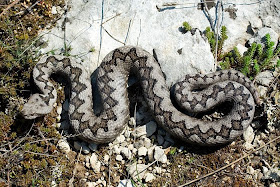 ammodytes is a venomous viper species found in southern Europe through to the Balkans and parts of the Middle East. It is reputed to be the most dangerous of the European vipers due to its large size, long fangs (up to 13 mm) and high venom toxicity. Five subspecies are currently recognized, including the nominate subspecies described here.
ammodytes is a venomous viper species found in southern Europe through to the Balkans and parts of the Middle East. It is reputed to be the most dangerous of the European vipers due to its large size, long fangs (up to 13 mm) and high venom toxicity. Five subspecies are currently recognized, including the nominate subspecies described here.
maximum length of 95 cm (37.62 in), although individuals usually measure less than 85 cm (33.66 in). Females are somewhat smaller than males. Maximum length also depends on race, with northern forms distinctly larger than southern ones. According to Strugariu (2006), the average length is 50–70 cm (20 to 28 in) with reports of specimens over 1 m (40 in) in length.
Common names
Horned viper, long-nosed viper, nose-horned viper, sand viper sand adder, common sand adder, common sand viper sand natter.
Behaviour
This species has no particular preference for its daily activity period. At higher altitudes, it is more active during the day. At lower altitudes, it may be found at any time of the day, becoming increasingly nocturnal as daytime temperatures rise.
This is likely the most dangerous snake to be found in Europe. In some areas it is at least a significant medical risk; in the past fatalities were relatively frequent in the Balkans because the peasants there had a habit of walking barefoot.
The venom can be quite toxic [based on tests conducted solely on mice], but varies over time and among different populations. Brown (1973) gives an LD50 for mice of 1.2 mg/kg IV, 1.5 mg/kg IP and 2.0 mg/kg SC. Novak et al. (1973) give ranges of 0.44-0.82 mg/kg and IV and 0.19-0.64 mg/kg IP. Minton (1974) states 6.6 mg/kg SC.


